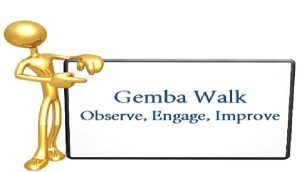 Gemba (Gemba Walk)
Gemba (Gemba Walk)
Initially developed by Taiichi Ohno, an executive at Toyota, to counter a common problem with complex projects. Whereby the project team and the people involved lose sight of the detailed work that goes into the very process they are trying to improve. Since its inception is has been developed and expanded to include almost every sector and industry. Where ever a process takes place a Gemba Walk can be performed.
An actual problem that can affect the company’s finances as well as the customer can become detached and transformed into reports, data and discussions that may not resolve the problem. This results in more frustration for the customer and those parts of the company that is affected by the problem.
Realising this problem, the concept of ‘Going to Gemba’ or going on a ‘Gemba Walk’ was developed. The translation is from the Japanese word means ‘the actual place’. It can also be taken as ‘the place where value is created’. It requires managers or process improvement team members to spend time observing the process and engaging with the staff who perform the process.
This provides first hand observations and enables an organisations leaders the chance to see the actual process rather than what they assume the process to be. It can also highlight any differences between what the process should be and what it is. At the same time the leaders can speak with staff who perform the process to get more understanding about how the process is performed.
However a Gemba walk is not for the following.
- To find fault and call out employees on it.
- To try to quickly implement a change on the spot.
- To disregard employee input. Getting that input is one of the main goals of a Gemba Walk.
Leaders need to focus on the process or operation, actively engage and listen to the feedback from employees and then reflect upon the what they have seen and heard to develop a course of action.
When done correctly an atmosphere of cooperation is created and all individuals see a Gemba Walk as an opportunity to improve the business and make a positive change.
If done incorrectly a Gemba Walk can decrease morale and make employees hesitant to share thoughts and ideas. As they will see a Gemba Walk as a means of punishing individuals.
Gemba walks can greatly benefit any company by observing the actual place of work, listening to people who perform the actual process and engage with the actual customer. Business ideas can be generated, and changes made that improve the product and services for the customer.
